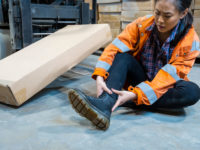OSHA requires protection from general workplace hazards that may cause injury or illness, and industries with heavy lifting or dangerous machinery are required to provide PPE. However, even with these measures in place, accidents can still happen.
OSHA general standards for Personal Protective Equipment (PPE) outline the necessary measures employers should take to protect employees from safety hazards. Still, these guidelines can be difficult to follow without knowing the dangers intrinsic to each employee's job. Warehouse and logistics facilities and businesses need to proactively address health and safety hazards, employers need to look at OSHA guidelines through an ergonomic lens.
There are four risk factors that manufacturing employers need to address in each and every workplace assessment: force, posture, repetition, and balance. By taking into account these risk factors when selecting PPE, warehouse and logistics professionals can ensure that their employees are safe on the job.
1. Force
Force is the amount of pressure an employee is exerting on a task. This can be due to the weight of the object they are lifting, or the amount of effort required to complete a task. Tasks that require a lot of force can lead to musculoskeletal injuries, such as strains and sprains. To protect employees from these injuries, employers should provide them with gloves, back supports, and most importantly, ergonomically designed and clinically proven, 100% dual layer memory foam insoles.
Employees working in manufacturing and logistics, who are required to do a lot of lifting, carrying and moving can benefit from the extra cushioning, shock absorption, and support that memory foam provides. Not only will this help keep employees healthy and safe, but it can also help reduce the amount of stress on the body, caused by force and minimize the risk of injuries.
2. Posture
Posture is the position in which an employee's body is positioned while they are working. Poor posture can lead to musculoskeletal disorders, such as carpal tunnel syndrome and tendonitis. To prevent these disorders, employers should provide employees with PPE that will help them maintain good posture while they are working. This may include ergonomic chairs, wrist supports, and anti-fatigue dual layer memory foam insoles.
Maintaining proper posture is not just about standing up right, it's also about avoiding awkward postures. Awkward postures are any position that puts strain on the musculoskeletal system. When the body is in an awkward posture, it is more likely to be injured. To avoid these injuries, employers should provide employees with PPE that will help them maintain good posture while they are working.
If we examine the activities of a warehouse employee, we can imagine their daily activities. Many of their movements include reaching, bending, and twisting. These are awkward postures that are easy to identify. However, beneath the surface we can pinpoint more detrimental effects of these awkward postures. For example, someone working on their feet all day, packing orders or retrieving parts would be susceptible to fatigue related collapsing of their foot arch. It may sound benign but when the arch of the foot collapses, there is a chain reaction of negative repercussions, felt all the way up to the lower back. In these moments, the body adjusts itself by internally rotating the knees, leading to an anterior pelvic tilt, increasing stress on the lumbar region.
Offering employees clinically proven anti-fatigue insoles helps reduce the effects of awkward postures, specifically ones involving fatigue related collapsing of the foot arch. This will help workers maintain good posture, while reducing the amount of stress on their bodies.
3. Repetition
Repetition is the number of times an employee performs a task in a given period of time. Tasks that are performed repetitively can lead to musculoskeletal disorders, such as tendonitis, carpal tunnel syndrome, and musculoskeletal disorders. To prevent these disorders, employers should provide employees with PPE that will help them reduce the amount of repetition in their work. This may include automation equipment, job rotation schedules and ergonomically designed tools and equipment.
One way to reduce the amount of repetition in a task is to provide employees with PPE that will help them perform the task with less effort. Clinically proven and ergonomically designed memory foam insoles can help reduce the effects of repetition on the body. These unique insoles improve blood circulation to the active and static muscles, which reduces discomfort and localized fatigue experienced in the feet, legs, knees, hips and lower back. Additionally, they can help distribute body weight more evenly, which helps reduce the risk of injury. For warehouse and logistics managers seeking to improve employee health and safety, memory foam insoles are an ideal solution.
4. Balance
Balance is the distribution of an employee's weight while they are working. Poor balance can lead to musculoskeletal injuries, such as sprains and strains. Warehouse and logistics managers and businesses have to realize it's not just about providing the proper safety gear anymore. In order to keep your employees healthy and safe, you need to provide them with ergonomic solutions to common daily workplace hazards.
Providing employees with an ergonomic solution that travels with them, companies can work to streamline the workplace floor, removing slip/trip/fall hazards, creating an environment that improves balance for all employees. For example, many factories utilize anti-fatigue matting to help employees find comfort and balance on the facility floor. Unfortunately, anti-fatigue matting is a balance hazard. Not only is it ineffective in its ability to cover the entire workplace, but dirty matting and peeling corners can create slips, trips and fall hazards.
On the other hand, offering employees clinically proven and ergonomically designed memory foam insoles helps improve balance and distribution of body weight. One of the greatest benefits of dual layer 100% memory foam insoles is that they have immediate contact with the wearer’s foot, providing maximum comfort and shock absorption. Furthermore, they travel with the wearer, eliminating slips, trips and fall hazards. Clinically proven, dual layer memory foam insoles can help reduce the risk of injury, while also improving blood circulation and reducing discomfort and localized fatigue. This is critical to warehouse and logistics employees that work in an environment where they are constantly standing or walking.
Not only are warehouse workers required to carry heavy and unwieldy items throughout the facility, but they may also be subject of hazardous activities like forklift truck driving or stairwell climbing. This is especially true for employees who must move thousands of boxes across hundreds of feet over several days, which adds up to a significant number of steps (upwards of 15,000 steps/day for some individuals). Warehouse facilities are no stranger to large rates of employee turnover in these firms as a result of job requirements.
One of the most important things to consider in a warehousing facility is employee well-being. With high rates of turnover, it's vital to pay attention to comfort and pain reduction to improve productivity and morale. Demonstrating a care for employee well-being, comfort, and pain alleviation is a vital piece to successfully retaining employees, increasing productivity and boosting morale.
By taking into account these four risk factors, employers can ensure that their employees are safe on the job. By providing employees with the proper PPE, employers can help reduce the number of workplace injuries, illnesses, reduce compensation claims and increase productivity and job satisfaction. OSHA guidelines mandate that employers assess ergonomic risk factors in the workplace. All companies have a moral obligation to keep their employees safe and healthy, to the best of their ability. Providing ergonomically designed and clinically proven insoles to employees, helps warehouse and logistics facilities and businesses ensure a safe and healthy workforce.



